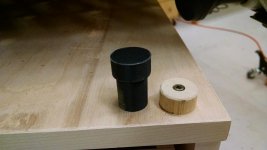I've had some down time this week, so I built my own version of a rolling MFT/3-Sysport using 18mm baltic birch plywood. The criteria were that it had to be built 100% on metric system (my first), it had to hold an MFT/3 (with legs folded) at normal height so it would line up with my other MFT/3 sitting on its own legs, it had to have the same footprint as an MFT/3, interior partitions had to be line-bored to accept drawer glides and/or shelves, and it had to be assembled using dominoes (I also used pocket screws to keep things together as the adhesive set up). I used 101.6mm locking casters from Woodcraft which are 130mm high including hardware, and sized all the component parts from there to achieve the goals. It's still a work in progress; I still have to acquire some Accuride glides and make the pull-out shelves. The center sections are likely to have drawers in which I can store boxes of abrasives for my various Festool sanders. In any case, it rolls around quite well and the locking casters hold it in place quite well. As you can see, I nailed the height just right. There are four 100mm x 50mm x 12mm pads glued and brad-nailed to the top as alignment blocks to keep the MFT/3 from slipping off during material manipulation. They are there for alignment only. The MFT/3 actually sits on its own pads. If any FOGgers are interested in the cut sheets which have dimensions, I can send them as a PDF file.
And yes, I know there's a nut missing on one of the caster pads. There was apparently a 1/4" nut in the box of 5/16" elastic nuts, so there's another trip to Lowe's.
Edit, 12/23/13: I did some re-thinking today of how I did the system holes in my Sysport, and have modified the narrative PDF file to reflect the re-think. Both the cutsheet and the narrative document are now attached to this message for your ease in downloading.
[smile]

